Page 270 of 341
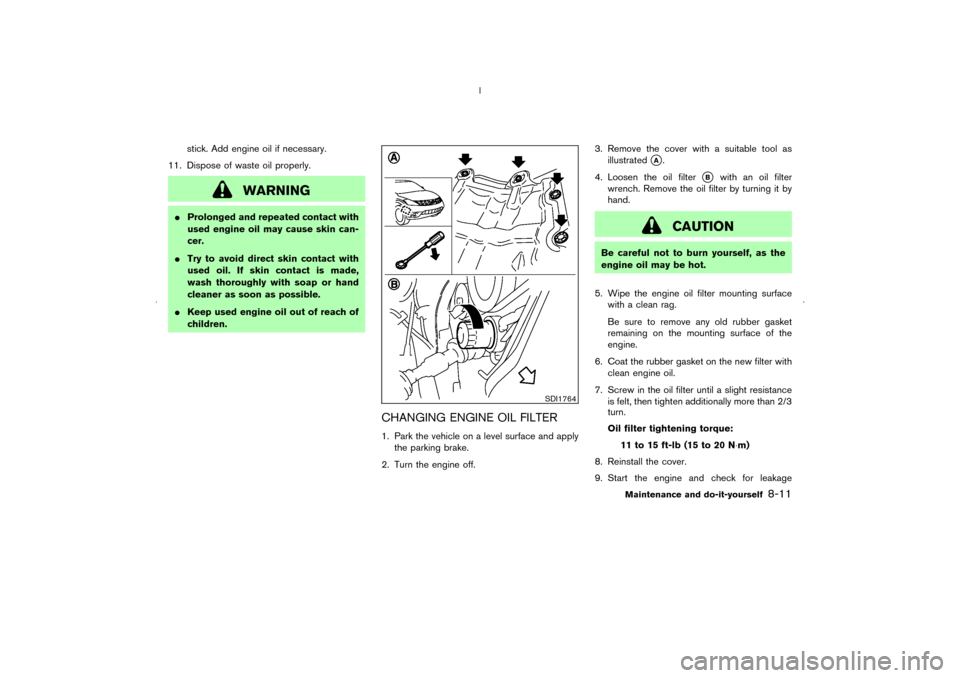
stick. Add engine oil if necessary.
11. Dispose of waste oil properly.
WARNING
�Prolonged and repeated contact with
used engine oil may cause skin can-
cer.
�Try to avoid direct skin contact with
used oil. If skin contact is made,
wash thoroughly with soap or hand
cleaner as soon as possible.
�Keep used engine oil out of reach of
children.
CHANGING ENGINE OIL FILTER1. Park the vehicle on a level surface and apply
the parking brake.
2. Turn the engine off.3. Remove the cover with a suitable tool as
illustrated
�A.
4. Loosen the oil filter
�B
with an oil filter
wrench. Remove the oil filter by turning it by
hand.
CAUTION
Be careful not to burn yourself, as the
engine oil may be hot.
5. Wipe the engine oil filter mounting surface
with a clean rag.
Be sure to remove any old rubber gasket
remaining on the mounting surface of the
engine.
6. Coat the rubber gasket on the new filter with
clean engine oil.
7. Screw in the oil filter until a slight resistance
is felt, then tighten additionally more than 2/3
turn.
Oil filter tightening torque:
11 to 15 ft-lb (15 to 20 N⋅m)
8. Reinstall the cover.
9. Start the engine and check for leakage
SDI1764
Maintenance and do-it-yourself
8-11
�
05.8.26/Z50-D/V5.0
�
Page 271 of 341
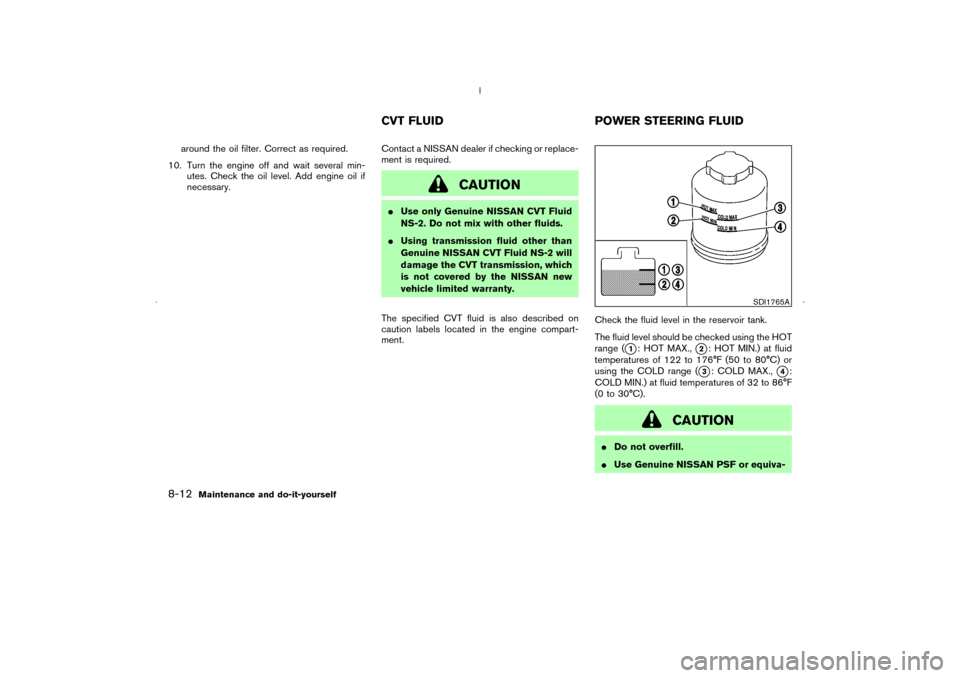
around the oil filter. Correct as required.
10. Turn the engine off and wait several min-
utes. Check the oil level. Add engine oil if
necessary.Contact a NISSAN dealer if checking or replace-
ment is required.
CAUTION
�Use only Genuine NISSAN CVT Fluid
NS-2. Do not mix with other fluids.
�Using transmission fluid other than
Genuine NISSAN CVT Fluid NS-2 will
damage the CVT transmission, which
is not covered by the NISSAN new
vehicle limited warranty.
The specified CVT fluid is also described on
caution labels located in the engine compart-
ment.Check the fluid level in the reservoir tank.
The fluid level should be checked using the HOT
range (
�1: HOT MAX.,
�2: HOT MIN.) at fluid
temperatures of 122 to 176°F (50 to 80°C) or
using the COLD range (�3: COLD MAX.,
�4:
COLD MIN.) at fluid temperatures of 32 to 86°F
(0 to 30°C).
CAUTION
�Do not overfill.
�Use Genuine NISSAN PSF or equiva-
SDI1765A
CVT FLUID POWER STEERING FLUID
8-12
Maintenance and do-it-yourself
�
05.8.26/Z50-D/V5.0
�
Page 274 of 341
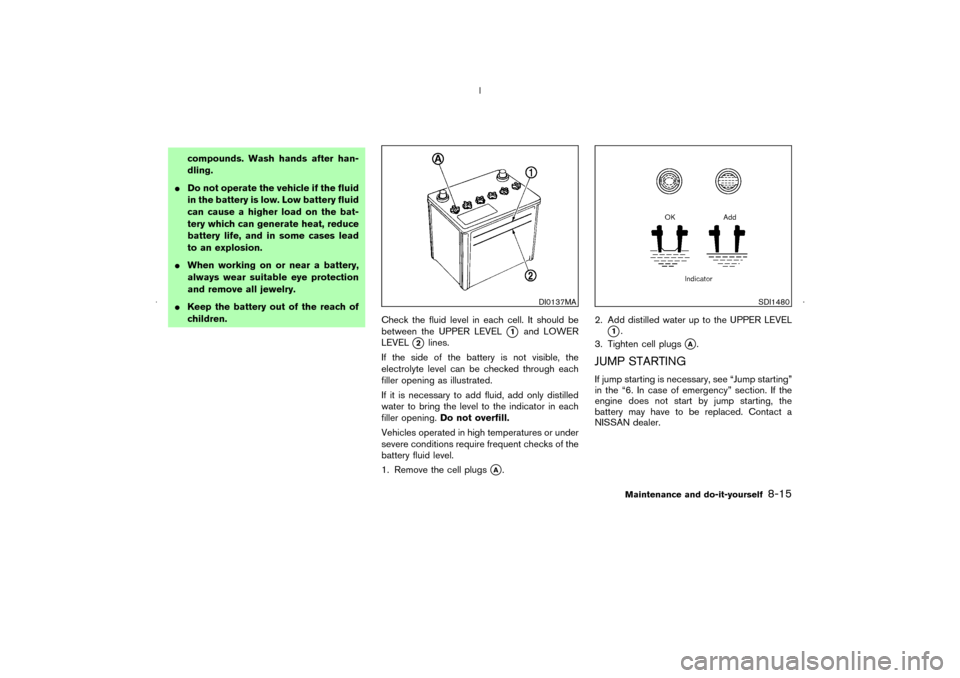
compounds. Wash hands after han-
dling.
�Do not operate the vehicle if the fluid
in the battery is low. Low battery fluid
can cause a higher load on the bat-
tery which can generate heat, reduce
battery life, and in some cases lead
to an explosion.
�When working on or near a battery,
always wear suitable eye protection
and remove all jewelry.
�Keep the battery out of the reach of
children.
Check the fluid level in each cell. It should be
between the UPPER LEVEL
�1
and LOWER
LEVEL
�2
lines.
If the side of the battery is not visible, the
electrolyte level can be checked through each
filler opening as illustrated.
If it is necessary to add fluid, add only distilled
water to bring the level to the indicator in each
filler opening.Do not overfill.
Vehicles operated in high temperatures or under
severe conditions require frequent checks of the
battery fluid level.
1. Remove the cell plugs
�A.2. Add distilled water up to the UPPER LEVEL
�1.
3. Tighten cell plugs
�A.
JUMP STARTINGIf jump starting is necessary, see “Jump starting”
in the “6. In case of emergency” section. If the
engine does not start by jump starting, the
battery may have to be replaced. Contact a
NISSAN dealer.
DI0137MA
SDI1480
Maintenance and do-it-yourself
8-15
�
05.8.26/Z50-D/V5.0
�
Page 275 of 341
WARNING
Be sure the ignition key is in the OFF or
LOCK position. The engine could rotate
unexpectedly.
1. Power steering oil pump
2. Idler pulley
3. Alternator
4. Crankshaft pulley
5. Air conditioner compressor
�: Tension checking pointsVisually inspect each belt for signs of unusual
wear, cuts, fraying, oil adhesion or looseness. If
the belt is in poor condition or loose, have it
replaced or adjusted by a NISSAN dealer.
Have the belts checked regularly for condition
and tension.
WARNING
Be sure the engine and ignition switch
are off and that the parking brake is
engaged securely.
CAUTION
Be sure to use the correct socket to
remove the spark plugs. An incorrect
socket can damage the spark plugs.
SDI0141B
DRIVE BELTS SPARK PLUGS8-16
Maintenance and do-it-yourself
�
05.8.26/Z50-D/V5.0
�
Page 279 of 341
Contact a NISSAN dealer if checking or replace-
ment is required.
CHECKING PARKING BRAKEFrom the released position, depress the parking
brake pedal slowly and firmly, and check the
notches between the initial and final positions of
the pedal. If it is out of the range shown above,
see a NISSAN dealer.
CHECKING BRAKE PEDALWith the engine running, check the distance
between the upper surface of the pedal and the
metal floor. If it is out of the range shown above,
see a NISSAN dealer.
Adjustable pedal equipped model:
The pedal must be in the front most position
when checking.Self-adjusting brakesYour vehicle is equipped with self-adjusting
brakes.
SDI1391C
DI1020MQ
REAR WINDOW WIPER BLADE
PARKING BRAKE AND BRAKE
PEDAL8-20
Maintenance and do-it-yourself
�
05.8.26/Z50-D/V5.0
�
Page 280 of 341
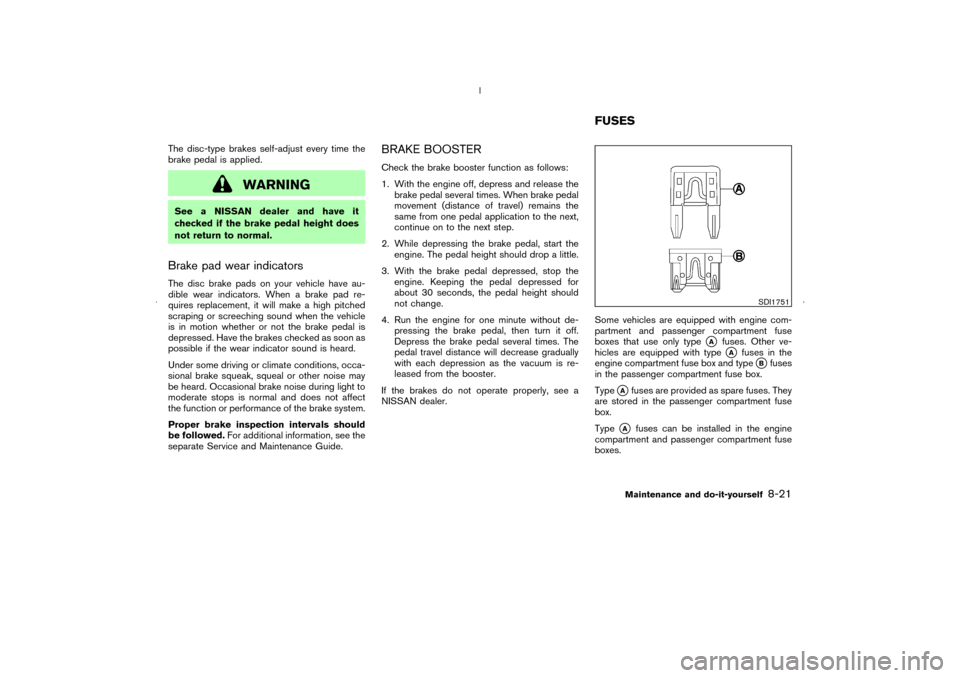
The disc-type brakes self-adjust every time the
brake pedal is applied.
WARNING
See a NISSAN dealer and have it
checked if the brake pedal height does
not return to normal.Brake pad wear indicatorsThe disc brake pads on your vehicle have au-
dible wear indicators. When a brake pad re-
quires replacement, it will make a high pitched
scraping or screeching sound when the vehicle
is in motion whether or not the brake pedal is
depressed. Have the brakes checked as soon as
possible if the wear indicator sound is heard.
Under some driving or climate conditions, occa-
sional brake squeak, squeal or other noise may
be heard. Occasional brake noise during light to
moderate stops is normal and does not affect
the function or performance of the brake system.
Proper brake inspection intervals should
be followed.For additional information, see the
separate Service and Maintenance Guide.
BRAKE BOOSTERCheck the brake booster function as follows:
1. With the engine off, depress and release the
brake pedal several times. When brake pedal
movement (distance of travel) remains the
same from one pedal application to the next,
continue on to the next step.
2. While depressing the brake pedal, start the
engine. The pedal height should drop a little.
3. With the brake pedal depressed, stop the
engine. Keeping the pedal depressed for
about 30 seconds, the pedal height should
not change.
4. Run the engine for one minute without de-
pressing the brake pedal, then turn it off.
Depress the brake pedal several times. The
pedal travel distance will decrease gradually
with each depression as the vacuum is re-
leased from the booster.
If the brakes do not operate properly, see a
NISSAN dealer.Some vehicles are equipped with engine com-
partment and passenger compartment fuse
boxes that use only type
�A
fuses. Other ve-
hicles are equipped with type�A
fuses in the
engine compartment fuse box and type
�Bfuses
in the passenger compartment fuse box.
Type
�Afuses are provided as spare fuses. They
are stored in the passenger compartment fuse
box.
Type
�A
fuses can be installed in the engine
compartment and passenger compartment fuse
boxes.
SDI1751
FUSES
Maintenance and do-it-yourself
8-21
�
05.8.26/Z50-D/V5.0
�
Page 281 of 341
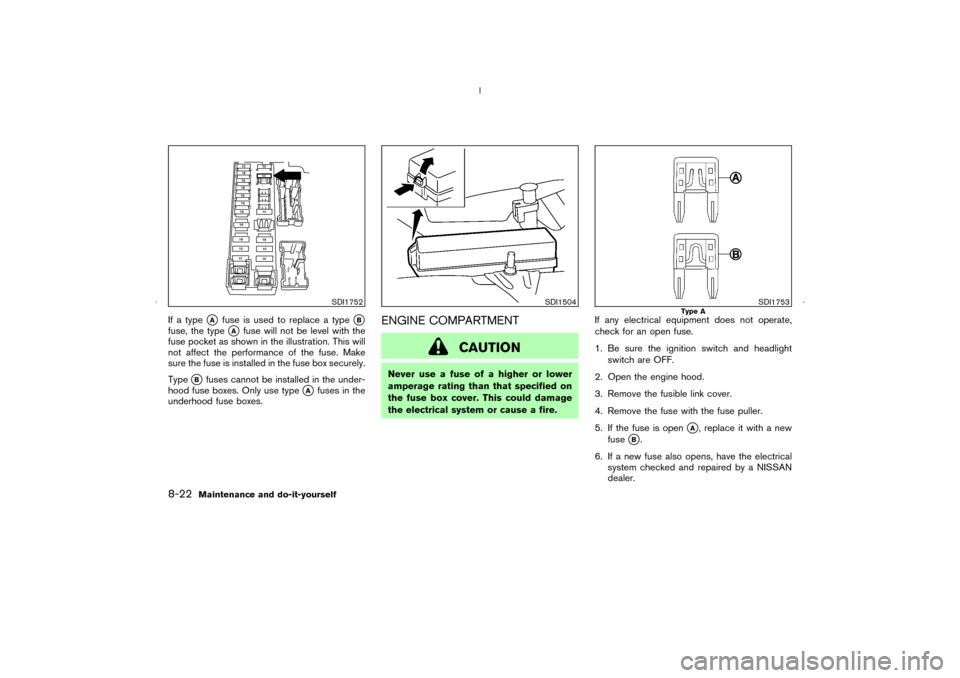
If a type
�A
fuse is used to replace a type
�B
fuse, the type
�A
fuse will not be level with the
fuse pocket as shown in the illustration. This will
not affect the performance of the fuse. Make
sure the fuse is installed in the fuse box securely.
Type
�B
fuses cannot be installed in the under-
hood fuse boxes. Only use type
�A
fuses in the
underhood fuse boxes.
ENGINE COMPARTMENT
CAUTION
Never use a fuse of a higher or lower
amperage rating than that specified on
the fuse box cover. This could damage
the electrical system or cause a fire.If any electrical equipment does not operate,
check for an open fuse.
1. Be sure the ignition switch and headlight
switch are OFF.
2. Open the engine hood.
3. Remove the fusible link cover.
4. Remove the fuse with the fuse puller.
5. If the fuse is open
�A, replace it with a new
fuse
�B.
6. If a new fuse also opens, have the electrical
system checked and repaired by a NISSAN
dealer.
SDI1752
SDI1504
SDI1753
Type A
8-22
Maintenance and do-it-yourself
�
05.8.26/Z50-D/V5.0
�
Page 307 of 341

engine stalling and hard hot starting are experi-
enced after using oxygenate-blend fuels, imme-
diately change to a non-oxygenate fuel or a fuel
with a low blend of MTBE.
Take care not to spill gasoline during refu-
eling. Gasoline containing oxygenates can
cause paint damage.E-85 fuelE-85 fuel is a mixture of approximately 85% fuel
ethanol and 15% unleaded gasoline. E-85 can
only be used in a Flexible Fuel Vehicle (FFV). Do
not use E-85 fuel in your vehicle. U.S. govern-
ment regulations require fuel ethanol dispensing
pumps to be identified by a small, square, or-
ange and black label with the common abbre-
viation or the appropriate percentage for that
region.Aftermarket fuel additivesNISSAN does not recommend the use of any
aftermarket fuel additives (for example, fuel in-
jector cleaner, octane booster, intake valve de-
posit removers, etc.) which are sold commer-
cially. Many of these additives intended for gum,
varnish or deposit removal may contain active
solvent or similar ingredients that can be harmful
to the fuel system and engine.
Octane rating tipsUsing unleaded gasoline with an octane
rating lower than recommended can cause
persistent, heavy spark knock. (Spark
knock is a metallic rapping noise.) If se-
vere, this can lead to engine damage. If you
detect a persistent heavy spark knock even
when using gasoline of the stated octane
rating, or if you hear steady spark knock
while holding a steady speed on level
roads, have your dealer correct the condi-
tion. Failure to correct the condition is
misuse of the vehicle, for which NISSAN is
not responsible.
Incorrect ignition timing will result in knocking,
after-run or overheating. This in turn may cause
excessive fuel consumption or damage to the
engine. If any of the above symptoms are en-
countered, have your vehicle checked at a
NISSAN dealer or other competent service fa-
cility.
However, now and then you may notice
light spark knock for a short time while
accelerating or driving up hills. This is no
cause for concern, because you get the
greatest fuel benefit when there is light
spark knock for a short time under heavy
engine load.
9-4
Technical and consumer information
�
05.8.26/Z50-D/V5.0
�